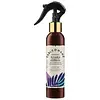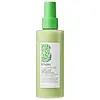What's inside
What's inside
 Key Ingredients
Key Ingredients

 Benefits
Benefits

 Concerns
Concerns

 Ingredients Side-by-side
Ingredients Side-by-side

Water
Skin ConditioningAloe Barbadensis Leaf Juice
Skin ConditioningPropanediol
SolventGlycerin
HumectantCetearyl Alcohol
EmollientPhyllanthus Emblica Fruit Extract
HumectantHydrolyzed Quinoa
Skin ConditioningHydrolyzed Adansonia Digitata Seed Extract
Hibiscus Sabdariffa Flower Extract
Skin ConditioningPhenoxyethanol
PreservativeBenzyl Alcohol
PerfumingCaprylic/Capric Triglyceride
MaskingParfum
MaskingCoconut Alkanes
EmollientCetyl Alcohol
EmollientOlealkonium Chloride
Behentrimonium Methosulfate
Behentrimonium Chloride
PreservativeVp/Va Copolymer
Xylitol
HumectantSalvia Hispanica Seed Extract
EmollientTrehalose
HumectantCaprylyl/Capryl Glucoside
CleansingCarthamus Tinctorius Seed Oil
MaskingEthyl Linoleate
EmollientIsopropyl Alcohol
SolventCoco-Caprylate/Caprate
EmollientEthyl Oleate
EmollientSorbitan Oleate
EmulsifyingPolyquaternium-37
Alcohol Denat.
AntimicrobialPolyquaternium-11
Stearamine Oxide
CleansingCaprylic/Capric Glycerides Polyglyceryl-10 Esters
EmollientGuar Hydroxypropyltrimonium Chloride
Skin ConditioningMyristyl Alcohol
EmollientStearyl Alcohol
EmollientSodium Phosphate
BufferingPolyquaternium-7
Caprylic Acid
CleansingOleamidopropyl Dimethylamine
Potassium Sorbate
PreservativeSodium Benzoate
MaskingAlcohol
AntimicrobialLaurtrimonium Chloride
EmulsifyingSodium Bisulfite
AntioxidantPentaerythrityl Tetra-Di-T-Butyl Hydroxyhydrocinnamate
AntioxidantTocopherol
AntioxidantBenzyl Salicylate
PerfumingLimonene
PerfumingHydroxycitronellal
PerfumingCitronellol
PerfumingWater, Aloe Barbadensis Leaf Juice, Propanediol, Glycerin, Cetearyl Alcohol, Phyllanthus Emblica Fruit Extract, Hydrolyzed Quinoa, Hydrolyzed Adansonia Digitata Seed Extract, Hibiscus Sabdariffa Flower Extract, Phenoxyethanol, Benzyl Alcohol, Caprylic/Capric Triglyceride, Parfum, Coconut Alkanes, Cetyl Alcohol, Olealkonium Chloride, Behentrimonium Methosulfate, Behentrimonium Chloride, Vp/Va Copolymer, Xylitol, Salvia Hispanica Seed Extract, Trehalose, Caprylyl/Capryl Glucoside, Carthamus Tinctorius Seed Oil, Ethyl Linoleate, Isopropyl Alcohol, Coco-Caprylate/Caprate, Ethyl Oleate, Sorbitan Oleate, Polyquaternium-37, Alcohol Denat., Polyquaternium-11, Stearamine Oxide, Caprylic/Capric Glycerides Polyglyceryl-10 Esters, Guar Hydroxypropyltrimonium Chloride, Myristyl Alcohol, Stearyl Alcohol, Sodium Phosphate, Polyquaternium-7, Caprylic Acid, Oleamidopropyl Dimethylamine, Potassium Sorbate, Sodium Benzoate, Alcohol, Laurtrimonium Chloride, Sodium Bisulfite, Pentaerythrityl Tetra-Di-T-Butyl Hydroxyhydrocinnamate, Tocopherol, Benzyl Salicylate, Limonene, Hydroxycitronellal, Citronellol
Water
Skin ConditioningPolyglyceryl-6 Stearate
EmollientCetearyl Alcohol
EmollientGlycerin
HumectantCetrimonium Chloride
AntimicrobialGlyceryl Stearate
EmollientIsopropyl Palmitate
EmollientPersea Gratissima Oil
Skin ConditioningActinidia Chinensis Fruit Extract
EmollientAloe Barbadensis Leaf Juice
Skin ConditioningMaltodextrin
AbsorbentPanthenol
Skin ConditioningSodium PCA
HumectantSpinacia Oleracea Leaf Extract
Skin ConditioningTocopheryl Acetate
AntioxidantHippophae Rhamnoides Fruit Oil
Skin ProtectingChlorophyllin-Copper Complex
AntioxidantTheobroma Cacao Seed Butter
EmollientSalvia Hispanica Seed Oil
MoisturisingBrassicyl Isoleucinate Esylate
Emulsion StabilisingBiotin
AntiseborrhoeicHelianthus Annuus Seed Oil
EmollientRosmarinus Officinalis Leaf Extract
AntimicrobialPolyglyceryl-6 Behenate
Emulsion StabilisingBrassica Alcohol
EmollientCitric Acid
BufferingPropanediol
SolventCaesalpinia Spinosa Fruit Extract
Skin ProtectingHelianthus Annuus Sprout Extract
Skin ConditioningSpirulina Maxima Extract
SmoothingPotassium Sorbate
PreservativeSodium Benzoate
MaskingSodium Hydroxide
BufferingParfum
MaskingCaprylhydroxamic Acid
Benzyl Alcohol
PerfumingWater, Polyglyceryl-6 Stearate, Cetearyl Alcohol, Glycerin, Cetrimonium Chloride, Glyceryl Stearate, Isopropyl Palmitate, Persea Gratissima Oil, Actinidia Chinensis Fruit Extract, Aloe Barbadensis Leaf Juice, Maltodextrin, Panthenol, Sodium PCA, Spinacia Oleracea Leaf Extract, Tocopheryl Acetate, Hippophae Rhamnoides Fruit Oil, Chlorophyllin-Copper Complex, Theobroma Cacao Seed Butter, Salvia Hispanica Seed Oil, Brassicyl Isoleucinate Esylate, Biotin, Helianthus Annuus Seed Oil, Rosmarinus Officinalis Leaf Extract, Polyglyceryl-6 Behenate, Brassica Alcohol, Citric Acid, Propanediol, Caesalpinia Spinosa Fruit Extract, Helianthus Annuus Sprout Extract, Spirulina Maxima Extract, Potassium Sorbate, Sodium Benzoate, Sodium Hydroxide, Parfum, Caprylhydroxamic Acid, Benzyl Alcohol
 Reviews
Reviews

Ingredients Explained
These ingredients are found in both products.
Ingredients higher up in an ingredient list are typically present in a larger amount.
Aloe Barbadensis Leaf Juice comes from leaves of the aloe plant. Aloe Barbadensis Leaf Juice is best known for helping to soothe sunburns. It is also anti-inflammatory, moisturizing, antiseptic, and can help heal wounds.
Aloe is packed with good stuff including Vitamins A, C, and E. These vitamins are antioxidants, which help fight free-radicals and the damage they may cause. Free-radicals are molecules that may damage your skin cells, such as pollution.
Aloe Barbadensis Leaf Juice also contains sugars. These sugars come in the form of monosaccharides and polysaccharides, folic acid, and choline. These sugars are able to help bind moisture to skin.
It also contains minerals such as calcium, 12 anthraquinones, fatty acids, amino acids, and Vitamin B12.
Learn more about Aloe Barbadensis Leaf JuiceBenzyl Alcohol is most commonly used as a preservative. It also has a subtle, sweet smell. Small amounts of Benzyl Alcohol is not irritating and safe to use in skincare products. Most Benzyl Alcohol is derived from fruits such as apricots.
Benzyl Alcohol has both antibacterial and antioxidant properties. These properties help lengthen the shelf life of products. Benzyl Alcohol is a solvent and helps dissolve other ingredients. It can also improve the texture and spreadability.
Alcohol comes in many different forms. Different types of alcohol will have different effects on skin. This ingredient is an astringent alcohol.
Using high concentrations of these alcohols are drying on the skin. They may strip away your skin's natural oils and even damage your skin barrier. Astringent alcohols may also irritate skin.
Other types of astringent alcohols include:
According to the National Rosacea Society based in the US, you should be mindful of products with these alcohols in the top half of ingredients.
Any type of sanitizing product will have high amounts of alcohol to help kill bacteria and viruses.
Learn more about Benzyl AlcoholCetearyl alcohol is a mixture of two fatty alcohols: cetyl alcohol and stearyl alcohol. It is mainly used as an emulsifier. Emulsifiers help prevent the separation of oils and products. Due to its composition, it can also be used to thicken a product or help create foam.
Cetearyl alcohol is an emollient. Emollients help soothe and hydrate the skin by trapping moisture.
Studies show Cetearyl alcohol is non-toxic and non-irritating. The FDA allows products labeled "alcohol-free" to have fatty alcohols.
This ingredient is usually derived from plant oils such as palm, vegetable, or coconut oils. There is debate on whether this ingredient will cause acne.
Due to the fatty acid base, this ingredient may not be Malassezia folliculitis safe.
Learn more about Cetearyl AlcoholGlycerin is already naturally found in your skin. It helps moisturize and protect your skin.
A study from 2016 found glycerin to be more effective as a humectant than AHAs and hyaluronic acid.
As a humectant, it helps the skin stay hydrated by pulling moisture to your skin. The low molecular weight of glycerin allows it to pull moisture into the deeper layers of your skin.
Hydrated skin improves your skin barrier; Your skin barrier helps protect against irritants and bacteria.
Glycerin has also been found to have antimicrobial and antiviral properties. Due to these properties, glycerin is often used in wound and burn treatments.
In cosmetics, glycerin is usually derived from plants such as soybean or palm. However, it can also be sourced from animals, such as tallow or animal fat.
This ingredient is organic, colorless, odorless, and non-toxic.
Glycerin is the name for this ingredient in American English. British English uses Glycerol/Glycerine.
Learn more about GlycerinParfum is a catch-all term for an ingredient or more that is used to give a scent to products.
Also called "fragrance", this ingredient can be a blend of hundreds of chemicals or plant oils. This means every product with "fragrance" or "parfum" in the ingredients list is a different mixture.
For instance, Habanolide is a proprietary trade name for a specific aroma chemical. When used as a fragrance ingredient in cosmetics, most aroma chemicals fall under the broad labeling category of “FRAGRANCE” or “PARFUM” according to EU and US regulations.
The term 'parfum' or 'fragrance' is not regulated in many countries. In many cases, it is up to the brand to define this term.
For instance, many brands choose to label themselves as "fragrance-free" because they are not using synthetic fragrances. However, their products may still contain ingredients such as essential oils that are considered a fragrance by INCI standards.
One example is Calendula flower extract. Calendula is an essential oil that still imparts a scent or 'fragrance'.
Depending on the blend, the ingredients in the mixture can cause allergies and sensitivities on the skin. Some ingredients that are known EU allergens include linalool and citronellol.
Parfum can also be used to mask or cover an unpleasant scent.
The bottom line is: not all fragrances/parfum/ingredients are created equally. If you are worried about fragrances, we recommend taking a closer look at an ingredient. And of course, we always recommend speaking with a professional.
Learn more about ParfumPotassium Sorbate is a preservative used to prevent yeast and mold in products. It is commonly found in both cosmetic and food products.
This ingredient comes from potassium salt derived from sorbic acid. Sorbic acid is a natural antibiotic and effective against fungus.
Both potassium sorbate and sorbic acid can be found in baked goods, cheeses, dried meats, dried fruit, ice cream, pickles, wine, yogurt, and more.
You'll often find this ingredient used with other preservatives.
Learn more about Potassium SorbatePropanediol is an all-star ingredient. It softens, hydrates, and smooths the skin.
It’s often used to:
Propanediol is not likely to cause sensitivity and considered safe to use. It is derived from corn or petroleum with a clear color and no scent.
Learn more about PropanediolSodium Benzoate is a preservative. It's used in both cosmetic and food products to inhibit the growth of mold and bacteria. It is typically produced synthetically.
Both the US FDA and EU Health Committee have approved the use of sodium benzoate. In the US, levels of 0.1% (of the total product) are allowed.
Sodium benzoate works as a preservative by inhibiting the growth of bacteria inside of cells. It prevents the cell from fermenting a type of sugar using an enzyme called phosphofructokinase.
It is the salt of benzoic acid. Foods containing sodium benzoate include soda, salad dressings, condiments, fruit juices, wines, and snack foods.
Studies for using ascorbic acid and sodium benzoate in cosmetics are lacking, especially in skincare routines with multiple steps.
We always recommend speaking with a professional, such as a dermatologist, if you have any concerns.
Learn more about Sodium BenzoateWater. It's the most common cosmetic ingredient of all. You'll usually see it at the top of ingredient lists, meaning that it makes up the largest part of the product.
So why is it so popular? Water most often acts as a solvent - this means that it helps dissolve other ingredients into the formulation.
You'll also recognize water as that liquid we all need to stay alive. If you see this, drink a glass of water. Stay hydrated!
Learn more about Water